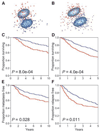MUC1-induced transcriptional programs associated with tumorigenesis predict outcome in breast and lung cancer
- PMID: 19318547
- PMCID: PMC3034477
- DOI: 10.1158/0008-5472.CAN-08-4513
MUC1-induced transcriptional programs associated with tumorigenesis predict outcome in breast and lung cancer
Abstract
The Mucin 1 (MUC1) oncoprotein is aberrantly overexpressed in diverse human malignancies including breast and lung cancer. Although MUC1 modulates the activity of several transcription factors, there is no information regarding the effects of MUC1 on global gene expression patterns and the potential role of MUC1-induced genes in predicting outcome for cancer patients. We have developed an experimental model of MUC1-induced transformation that has identified the activation of gene families involved in oncogenesis, angiogenesis, and extracellular matrix remodeling. A set of experimentally derived MUC1-induced genes associated with tumorigenesis was applied to the analysis of breast and lung adenocarcinoma cancer databases. A 35-gene MUC1-induced tumorigenesis signature predicts significant decreases in both disease-free and overall survival in patients with breast (n=295) and lung (n=442) cancers. The data show that the MUC1 oncoprotein contributes to the regulation of genes that are highly predictive of clinical outcome in breast and lung cancer patients.
Conflict of interest statement
D.W. Kufe has interest in and is a consultant to Genus Oncology. The other authors disclosed no potential conflicts of interest.
Figures




References
-
- Duraisamy S, Kufe T, Ramasamy S, Kufe D. Evolution of the human MUC1 oncoprotein. Int J Oncol. 2007;31:671–677. - PubMed
-
- Ligtenberg MJ, Kruijshaar L, Buijs F, van Meijer M, Litvinov SV, Hilkens J. Cell-associated episialin is a complex containing two proteins derived from a common precursor. J Biol Chem. 1992;267:6171–6177. - PubMed
-
- Macao B, Johansson DG, Hansson GC, Hard T. Autoproteolysis coupled to protein folding in the SEA domain of the membrane-bound MUC1 mucin. Nat Struct Mol Biol. 2006;13:71–76. - PubMed
-
- Merlo GR, Siddiqui J, Cropp CS, et al. Frequent alteration of the DF3 tumor-associated antigen gene in primary human breast carcinomas. Cancer Res. 1989;49:6966–6971. - PubMed
Publication types
MeSH terms
Substances
Grants and funding
LinkOut - more resources
Full Text Sources
Other Literature Sources
Medical
Research Materials
Miscellaneous

